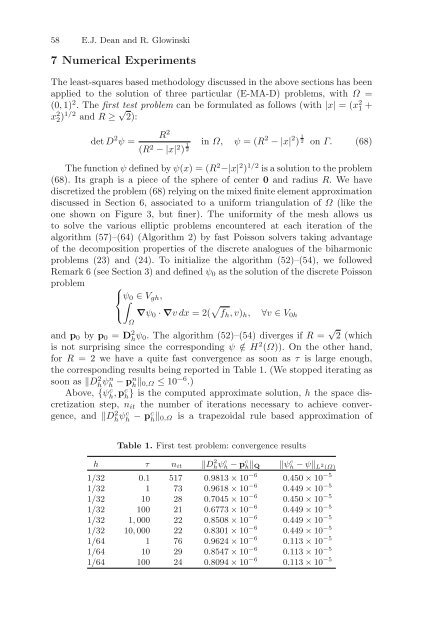Partial Differential Equations - Modelling and ... - ResearchGate
Partial Differential Equations - Modelling and ... - ResearchGate
Partial Differential Equations - Modelling and ... - ResearchGate
You also want an ePaper? Increase the reach of your titles
YUMPU automatically turns print PDFs into web optimized ePapers that Google loves.
58 E.J. Dean <strong>and</strong> R. Glowinski<br />
7 Numerical Experiments<br />
The least-squares based methodology discussed in the above sections has been<br />
applied to the solution of three particular (E-MA-D) problems, with Ω =<br />
(0, 1) 2 .Thefirst test problem can be formulated as follows (with |x| =(x 2 1 +<br />
x 2 2) 1/2 <strong>and</strong> R ≥ √ 2):<br />
R 2<br />
det D 2 ψ =<br />
(R 2 −|x| 2 ) 1 2<br />
in Ω, ψ =(R 2 −|x| 2 ) 1 2 on Γ. (68)<br />
The function ψ defined by ψ(x) =(R 2 −|x| 2 ) 1/2 is a solution to the problem<br />
(68). Its graph is a piece of the sphere of center 0 <strong>and</strong> radius R. Wehave<br />
discretized the problem (68) relying on the mixed finite element approximation<br />
discussed in Section 6, associated to a uniform triangulation of Ω (like the<br />
one shown on Figure 3, but finer). The uniformity of the mesh allows us<br />
to solve the various elliptic problems encountered at each iteration of the<br />
algorithm (57)–(64) (Algorithm 2) by fast Poisson solvers taking advantage<br />
of the decomposition properties of the discrete analogues of the biharmonic<br />
problems (23) <strong>and</strong> (24). To initialize the algorithm (52)–(54), we followed<br />
Remark 6 (see Section 3) <strong>and</strong> defined ψ 0 as the solution of the discrete Poisson<br />
problem ⎧<br />
⎨ ψ<br />
∫ 0 ∈ V gh ,<br />
⎩ ∇ψ 0 · ∇vdx=2( √ f h ,v) h , ∀v ∈ V 0h<br />
Ω<br />
<strong>and</strong> p 0 by p 0 = D 2 h ψ 0. The algorithm (52)–(54) diverges if R = √ 2 (which<br />
is not surprising since the corresponding ψ /∈ H 2 (Ω)). On the other h<strong>and</strong>,<br />
for R = 2 we have a quite fast convergence as soon as τ is large enough,<br />
the corresponding results being reported in Table 1. (We stopped iterating as<br />
soon as ‖Dh 2ψn h − pn h ‖ 0,Ω ≤ 10 −6 .)<br />
Above, {ψh c, pc h<br />
} is the computed approximate solution, h the space discretization<br />
step, n it the number of iterations necessary to achieve convergence,<br />
<strong>and</strong> ‖Dh 2ψc h − pc h ‖ 0,Ω is a trapezoidal rule based approximation of<br />
Table 1. First test problem: convergence results<br />
h τ n it ‖Dhψ 2 h c − p c h‖ Q ‖ψh c − ψ‖ L 2 (Ω)<br />
1/32 0.1 517 0.9813 × 10 −6 0.450 × 10 −5<br />
1/32 1 73 0.9618 × 10 −6 0.449 × 10 −5<br />
1/32 10 28 0.7045 × 10 −6 0.450 × 10 −5<br />
1/32 100 21 0.6773 × 10 −6 0.449 × 10 −5<br />
1/32 1, 000 22 0.8508 × 10 −6 0.449 × 10 −5<br />
1/32 10, 000 22 0.8301 × 10 −6 0.449 × 10 −5<br />
1/64 1 76 0.9624 × 10 −6 0.113 × 10 −5<br />
1/64 10 29 0.8547 × 10 −6 0.113 × 10 −5<br />
1/64 100 24 0.8094 × 10 −6 0.113 × 10 −5
















